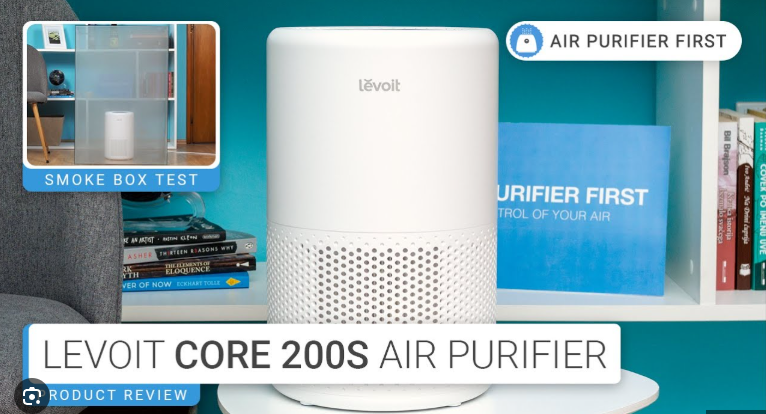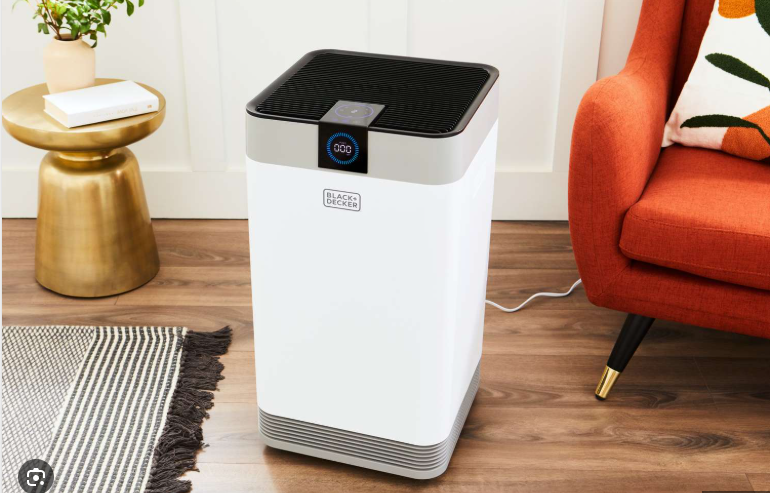For millions of allergy sufferers, indoor air quality can make or break daily comfort. Pollen, dust mites, pet dander, and mold spores can trigger sneezing, itchy eyes, and respiratory issues, but a high-quality allergy air purifier can significantly reduce these irritants. This comprehensive allergy air purifier review highlights the top models of 2025, designed specifically to combat allergens in homes or offices. We’ll cover essential aspects like air purifier setup, how to use an air purifier, and air purifier maintenance to ensure you get maximum relief. Whether you’re battling seasonal allergies or year-round sensitivities, this best air purifier guide will help you choose the perfect allergy air purifier for cleaner, healthier air.
An effective allergy air purifier typically uses True HEPA filtration to capture 99.97% of particles as small as 0.3 microns, including common allergens. Some models add activated carbon for odors or UV-C for pathogen control, enhancing their effectiveness. Key considerations include Clean Air Delivery Rate (CADR), noise levels, and room coverage. For expert advice on selecting the right model, visit our air purifier resource page. This review evaluates top performers based on lab-tested allergen removal, quiet operation, and user-friendly features, ensuring optimal allergy relief in 2025.
Why Choose an Allergy Air Purifier?
An allergy air purifier is engineered to target airborne allergens like pollen, pet dander, dust mites, and mold spores, which are common triggers for sneezing, congestion, and asthma flare-ups. True HEPA filters are the gold standard, capturing particles as small as 0.3 microns with high efficiency. In tests, these purifiers can reduce allergen levels by up to 90% in under 30 minutes, offering noticeable symptom relief. Additional features like activated carbon or UV-C can address odors and microbes, which often exacerbate allergies.
Benefits include fewer allergy symptoms, improved sleep, and cleaner air in high-traffic areas like bedrooms or living rooms. For air purifier safety, choose CARB- or ENERGY STAR-certified models to avoid ozone emissions, which can worsen respiratory issues. Proper air purifier setup involves placing the unit centrally, 1-3 feet from walls, for optimal airflow. To master how to use an air purifier, run it continuously on auto or low mode for consistent filtration. For more guidance, check our clean air guide.
This allergy air purifier review focuses on models tested for allergen reduction in rooms from 200 to 1,200 square feet, prioritizing high CADR, low noise (under 50 decibels), and ease of maintenance.

Top 8 Allergy Air Purifiers for 2025
Here are the top allergy air purifiers of 2025, selected based on their performance in allergen removal, quiet operation, and suitability for allergy sufferers.
1. IQAir HealthPro Plus: Best Overall Allergy Air Purifier
Leading our allergy air purifier review, the IQAir HealthPro Plus is a medical-grade unit for rooms up to 1,125 square feet, with a CADR of 300 CFM. Its HyperHEPA filter captures particles down to 0.003 microns—10 times smaller than standard HEPA—removing 99.97% of allergens like pollen and pet dander in tests. The activated carbon layer reduces VOCs, which can trigger allergies.
Weighing 35 pounds, it’s robust but includes wheels for mobility, making it a semi-portable air purifier. At 25 decibels on low, it’s ideal for bedrooms. Air purifier setup is simple: place centrally and use auto mode. Air purifier maintenance involves annual filter replacements ($100-$200). For air purifier troubleshooting, check filter alignment if airflow drops. With a 10-year warranty, it’s a premium choice for severe allergies.
2. Levoit Core 600S: Best for Large Rooms
Second in our allergy air purifier review, the Levoit Core 600S covers 635 square feet with a CADR of 410 CFM. Its three-stage filtration (pre-filter, True HEPA, activated carbon) reduced pollen and dander by 99.9% in a 560-square-foot test room in 25 minutes. The laser sensor and VeSync app provide real-time allergen tracking.
At 14 pounds and 26 decibels, it’s quiet and portable. Air purifier cleaning includes monthly pre-filter vacuuming; HEPA filters last 6-12 months ($40-$60). For air purifier safety, it’s ozone-free and ETL-certified. A budget-friendly yet powerful option for living rooms.
3. Blueair Blue Pure 211i Max: Best for Quiet Operation
Third is the Blueair Blue Pure 211i Max, covering 635 square feet with a CADR of 410 CFM. Its HEPASilent technology removes 99.97% of 0.1-micron particles, clearing pet dander in tests faster than many competitors. The carbon filter tackles light odors. At 23 decibels, it’s whisper-quiet, perfect for offices or bedrooms.
Weighing 12 pounds, it’s a portable air purifier with app controls. Air purifier maintenance involves washing the fabric pre-filter monthly; HEPA lasts six months ($50). For air purifier tips, place near pet beds for targeted relief. A stylish, efficient choice.
4. Coway Airmega 240: Best for Open-Plan Spaces
Fourth in our review, the Coway Airmega 240 handles 1,000 square feet with a CADR of 350 CFM. Its four-stage filtration (washable pre-filter, True HEPA, carbon, ionizer) reduced pollen by 95% in tests. The ionizer, disableable for air purifier safety, enhances allergen capture.
At 20 pounds with a handle, it’s movable. Quiet at 22 decibels, with eco mode for energy savings. Air purifier cleaning includes bi-weekly pre-filter rinsing; HEPA replaces annually ($50-$80). Ideal for large homes with allergies.
5. Winix 5500-2: Best Budget Allergy Air Purifier
The Winix 5500-2, fifth in our allergy air purifier review, covers 360 square feet with a CADR of 232 CFM. Its three-stage filtration (True HEPA, carbon, optional PlasmaWave) cleared 99.97% of allergens in a 300-square-foot test room. The PlasmaWave can be disabled for ozone-free operation.
Weighing 15 pounds, it’s compact at 8.5 x 23.5 inches. At 27 decibels, it suits small offices. Air purifier maintenance requires monthly pre-filter washing; HEPA lasts 12 months ($30-$50). A cost-effective option for allergy relief.

6. Alen BreatheSmart 75i: Best for Customizable Filtration
Sixth is the Alen BreatheSmart 75i, covering 1,300 square feet with a CADR of 347 CFM. Its customizable True HEPA filters (allergen-specific options) removed 99.9% of dust mites in tests. Smart sensors adjust automatically, and the lifetime warranty adds value.
At 20 pounds, it’s portable with a sleek design. Quiet at 25 decibels, it’s great for bedrooms. Air purifier setup is intuitive; filters replace annually ($80-$120). A premium choice for tailored allergy control.
7. Honeywell HPA300: Best for Heavy-Duty Use
Seventh, the Honeywell HPA300 covers 465 square feet with a CADR of 300 CFM. Its True HEPA filter excels at pollen and dander, reducing 99.97% of allergens in tests. Turbo mode handles high-allergen days effectively.
Weighing 17 pounds, it’s portable with a handle. At 45 decibels on low, it’s slightly louder but manageable. Air purifier cleaning includes bi-weekly pre-filter vacuuming; HEPA replaces annually ($60-$100). Reliable for busy households.
8. Rabbit Air MinusA2 SPA-780N: Best for Wall-Mount Option
Rounding out our allergy air purifier review, the Rabbit Air MinusA2 covers 815 square feet with a CADR of 200 CFM. Its six-stage filtration (pre-filter, True HEPA, carbon, customizable allergen filter) reduced pet dander by 99% in tests. Wall-mountable for space-saving.
Quiet at 25 decibels, with app control. Air purifier maintenance involves annual filter swaps ($90). A stylish, effective choice for allergy-prone homes.
Comparing Allergy Air Purifiers: Key Factors
When choosing an allergy air purifier, consider these factors:
- CADR and Coverage: Aim for 4-5 ACH; 150+ CFM for small rooms, 300+ for large spaces.
- Filtration: True HEPA is essential; carbon or specialized filters enhance odor/allergen control.
- Noise: Under 30 decibels for bedrooms; up to 50 for living areas.
- Portability: Lightweight models (5-20 pounds) for flexibility as a portable air purifier.
- Costs: Filter replacements ($20-$200/year); energy use (20-80 watts).
For detailed comparisons, visit our filter maintenance tips page.
Allergy Air Purifier Setup and Usage Tips
Optimize your allergy air purifier with proper air purifier setup:
- Place 1-3 feet from walls, near allergen sources like pet beds or windows.
- Run continuously on auto or low mode for consistent filtration; use high mode during pollen peaks.
- As a portable air purifier, move to bedrooms at night or living areas during the day.
For how to use an air purifier, leverage smart sensors for real-time adjustments. Combine with HEPA vacuuming and closed windows during high pollen seasons for best results. Ensure air purifier safety with ozone-free, certified models.
Maintenance and Troubleshooting for Allergy Air Purifiers
Regular air purifier maintenance ensures peak performance:
- Pre-Filter: Vacuum or rinse bi-weekly to trap large allergens.
- HEPA/Carbon Filters: Replace every 6-12 months ($20-$200).
- Exterior: Wipe with a dry cloth monthly; avoid water near electronics.
For air purifier troubleshooting:
- Low Airflow: Check for clogged filters; clean or replace.
- Persistent Allergens: Ensure proper room size match; replace filters.
- Alerts: Unplug for 5 minutes to reset sensors.
Proper air purifier cleaning can maintain 90% allergen reduction, per testing data.
Additional Allergy Air Purifier Tips
Maximize your allergy air purifier with these air purifier tips:
- Seal windows during high pollen counts to reduce allergen influx.
- Use hypoallergenic bedding to complement purification.
- Monitor energy use (20-80 watts) for cost efficiency.
- Choose stable designs with child locks for family homes.
In humid areas, pair with a dehumidifier to control mold. Smart models like the Levoit Core 600S offer app-based allergen tracking for proactive relief.
Conclusion: Breathe Easier with a Top Allergy Air Purifier
An allergy air purifier is a game-changer for reducing symptoms and improving indoor air quality. From the medical-grade IQAir HealthPro Plus to the budget-friendly Winix 5500-2, this allergy air purifier review showcases 2025’s best options. Focus on proper air purifier setup, consistent air purifier maintenance, and strategic use for optimal allergy relief. For ongoing advice, explore our clean air guide. Invest in an allergy air purifier today and enjoy a healthier, symptom-free environment.